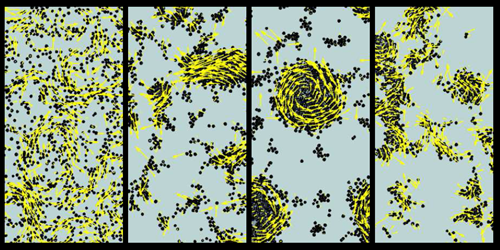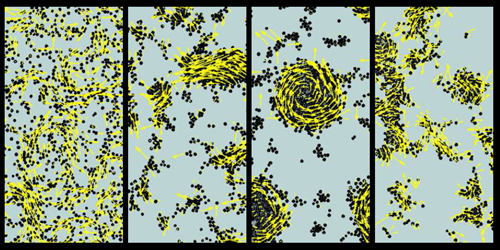Collective Dynamics from Individual Random Walks
An experiment that emulates the random motion of a sperm cell or a self-propelling bacterium has reproduced some of the collective dynamics seen in groups of these microswimmers. A team lead by Petia Vlahovska at Northwestern University in Illinois, mobilized a swarm of 40- -diameter polystyrene beads using an electrodynamic phenomenon called the Quincke effect. Whereas previous studies have used this effect to drive beads along gradually curving paths, Vlahovska and colleagues succeeded in recreating the more realistic “run-and-tumble” behavior of bacteria, with straight-line bursts punctuated by abrupt reorientations.
The team placed beads in an oil-filled chamber permeated by an electric field that polarized the beads and set them rolling in random directions along the bottom surface. Turning the field off and on again halted and restarted the beads’ motion. If the field was off only briefly, the beads retained their original polarization and resumed moving in roughly the same direction. However, if the beads were allowed to depolarize completely, this memory effect disappeared and was replaced by random restart directions when the field was reactivated.
The researchers found that varying the strength of the memory effect caused the beads to cluster into different configurations that mimicked the swarming and bunching exhibited by bacteria. The degree of similarity was surprising, they say, as the particle interactions that control collective behavior are different in the two cases: whereas jostling bacteria interact only mechanically, the polarized beads do so also through electrostatic forces. Still, the team believes that further study of Quincke-driven beads could uncover how optimal swimming strategies change in crowded microbial habitats, such as the soil or gut.
This research is published in Physical Review Letters.
–Marric Stephens
Marric Stephens is a freelance science writer based in Bristol, UK.





